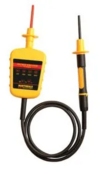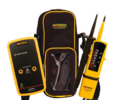You are using an out of date browser. It may not display this or other websites correctly.
You should upgrade or use an alternative browser.
You should upgrade or use an alternative browser.
Whicb Proving Unit ?
- Thread starter jcaan
- Start date
Sponsored Links
I use a Megger one at work, it's magnetic so quite good to use in my line of work.
This link might help
This link might help
- Joined
- 27 Jan 2008
- Messages
- 24,996
- Reaction score
- 2,894
- Location
- Llanfair Caereinion, Nr Welshpool
- Country

I have a 12 volt 12 Ah jump starter lamp and compressor, it was left to me, it has a 13 amp socket 300 VA, so I use that as a proving unit when required, it is not ideal as it does not ramp up the voltages, a proper proving unit should show the tester will work at 50 volt AC or 75 volt DC i.e. any voltage over extra low voltage must work the voltage tester, be it AC or DC or anywhere between the start of the low voltage range and likely maximum, so should step test both AC and DC.
To be frank the issued proving unit I had was 500 volt AC so rather pointless, as the tester may show all lights 12, 50, 100, 250, 500 etc. But you don't know if any would actually show at 50 volt AC or 75 volt DC so the unit is only to satisfy the safety officer it is really worthless.
To be frank the issued proving unit I had was 500 volt AC so rather pointless, as the tester may show all lights 12, 50, 100, 250, 500 etc. But you don't know if any would actually show at 50 volt AC or 75 volt DC so the unit is only to satisfy the safety officer it is really worthless.
Sponsored Links
I use one of these
The resistance test is very useful for checking immersion heaters
The resistance test is very useful for checking immersion heaters
An odd thing to say. Why particularly?The resistance test is very useful for checking immersion heaters
An odd thing to say. Why particularly?
Saves getting my MFT out
You will need that for insulation resistance, and a heating element either has continuity or is open. There is no validity in seeing what the resistance of the element is.Saves getting my MFT out
- Joined
- 27 Jan 2008
- Messages
- 24,996
- Reaction score
- 2,894
- Location
- Llanfair Caereinion, Nr Welshpool
- Country

I have not yet seen a proving unit that uses both AC and DC through a range of voltages. There may be one. The same applies to tester, must not be able to be switched off, even with discharged batteries, or turned to another function, and must be AC and DC.
However few fit the criteria, and I suspect most can use a multi-meter safely, so in real terms we are looking for test kit to satisfy a safety officer, rather than one guaranteed to do the job.
I have even after testing for dead had a supply been made live by a relay which we had no idea fed the cable in question. Lucky no one hurt, and no damage, but just good luck, and using all the correct equipment did not help.
So we do a risk assessment, we could not trace the cables due to concrete build up, it was a batching plant, so after the event it was decided we could only remove the redundant cables when plant not in use.
Even in a domestic (house) have found a socket connected to next doors supply.
So what is the highest risk, removing screws to gain access to use a tester, or use a non contact tester which could give wrong results? Most will test using a variety of testers, including a neon screwdriver to detect borrowed neutrals. It is true a clamp-on may also find borrowed neutrals, if you can actually get its jaws around the cables.
So in the main proving units are to satisfy some safety officer, so let them select what should be used.
However few fit the criteria, and I suspect most can use a multi-meter safely, so in real terms we are looking for test kit to satisfy a safety officer, rather than one guaranteed to do the job.
I have even after testing for dead had a supply been made live by a relay which we had no idea fed the cable in question. Lucky no one hurt, and no damage, but just good luck, and using all the correct equipment did not help.
So we do a risk assessment, we could not trace the cables due to concrete build up, it was a batching plant, so after the event it was decided we could only remove the redundant cables when plant not in use.
Even in a domestic (house) have found a socket connected to next doors supply.
So what is the highest risk, removing screws to gain access to use a tester, or use a non contact tester which could give wrong results? Most will test using a variety of testers, including a neon screwdriver to detect borrowed neutrals. It is true a clamp-on may also find borrowed neutrals, if you can actually get its jaws around the cables.
So in the main proving units are to satisfy some safety officer, so let them select what should be used.
There is no validity in seeing what the resistance of the element is.
It does show open circuit or the value of the resistance for a good unit
A helpful start with basic fault finding
The value of the resistance is irrelevant.It does show open circuit or the value of the resistance for a good unit
All that is required is open or continuity, which any continuity tester will do.
The resistance measurement feature on the more expensive Fluke models is pointless.
The resistance measurement feature on the more expensive Fluke models is pointless.
Because? If you want to confirm the heating element hadn’t failed then it’s ideal
Cheapo tester shows continuity or open. This is element intact or busted.
Expensive Fluke piece shows the actual resistance of the element or open. This is element intact or busted.
You are paying 3x the price just to see the actual resistance of the element in ohms, which is of no additional value in determining if the element is intact or not.
Expensive Fluke piece shows the actual resistance of the element or open. This is element intact or busted.
You are paying 3x the price just to see the actual resistance of the element in ohms, which is of no additional value in determining if the element is intact or not.
- Joined
- 27 Jan 2008
- Messages
- 24,996
- Reaction score
- 2,894
- Location
- Llanfair Caereinion, Nr Welshpool
- Country

I thought question was about proving unit? Not the tester? However I have found in the past using a proving unit not designed for the tester has caused problems, where the tester has used more power than the proving unit could deliver.
But if a tester can measure open circuit, the big question is can it have the wrong scale selected? Personally I am happy using a multi-meter to test for dead, but am also aware this would not be allowed by some safety officers, only worked in one place where proving units were always used, and it was site pass removed if caught without one at ones side, which in real terms meant the sack.
But the proving unit we had to use only produced 500 volt AC so a bit useless as it did not prove the tester would show over 50 volt AC or 75 volt DC so using my jump starter kit was just as good as the proving unit.
Once you has any other scale selectable other than volts then the tester may be considered not to comply, and it needs to test AC and DC without swapping and range scale switch. This has been the tester used for years to prove dead, no switches, works AC and DC no batteries. There are LED versions
has been the tester used for years to prove dead, no switches, works AC and DC no batteries. There are LED versions  often sold with the proving unit, that way one is sure it will work.
often sold with the proving unit, that way one is sure it will work.
But if a tester can measure open circuit, the big question is can it have the wrong scale selected? Personally I am happy using a multi-meter to test for dead, but am also aware this would not be allowed by some safety officers, only worked in one place where proving units were always used, and it was site pass removed if caught without one at ones side, which in real terms meant the sack.
But the proving unit we had to use only produced 500 volt AC so a bit useless as it did not prove the tester would show over 50 volt AC or 75 volt DC so using my jump starter kit was just as good as the proving unit.
Once you has any other scale selectable other than volts then the tester may be considered not to comply, and it needs to test AC and DC without swapping and range scale switch. This
 has been the tester used for years to prove dead, no switches, works AC and DC no batteries. There are LED versions
has been the tester used for years to prove dead, no switches, works AC and DC no batteries. There are LED versions  often sold with the proving unit, that way one is sure it will work.
often sold with the proving unit, that way one is sure it will work.Expensive Fluke piece shows the actual resistance of the element or open. This is element intact or busted.
You are paying 3x the price just to see the actual resistance of the element in ohms, which is of no additional value in determining if the element is intact or not.
It does what I need on occasions - which is confirm if the element is ok and has a reading of around 20 ohms ……….
As I stated before that’s enough for basic testing
DIYnot Local
Staff member
If you need to find a tradesperson to get your job done, please try our local search below, or if you are doing it yourself you can find suppliers local to you.
Select the supplier or trade you require, enter your location to begin your search.
Please select a service and enter a location to continue...
Are you a trade or supplier? You can create your listing free at DIYnot Local
Sponsored Links
Similar threads
- Replies
- 17
- Views
- 829
